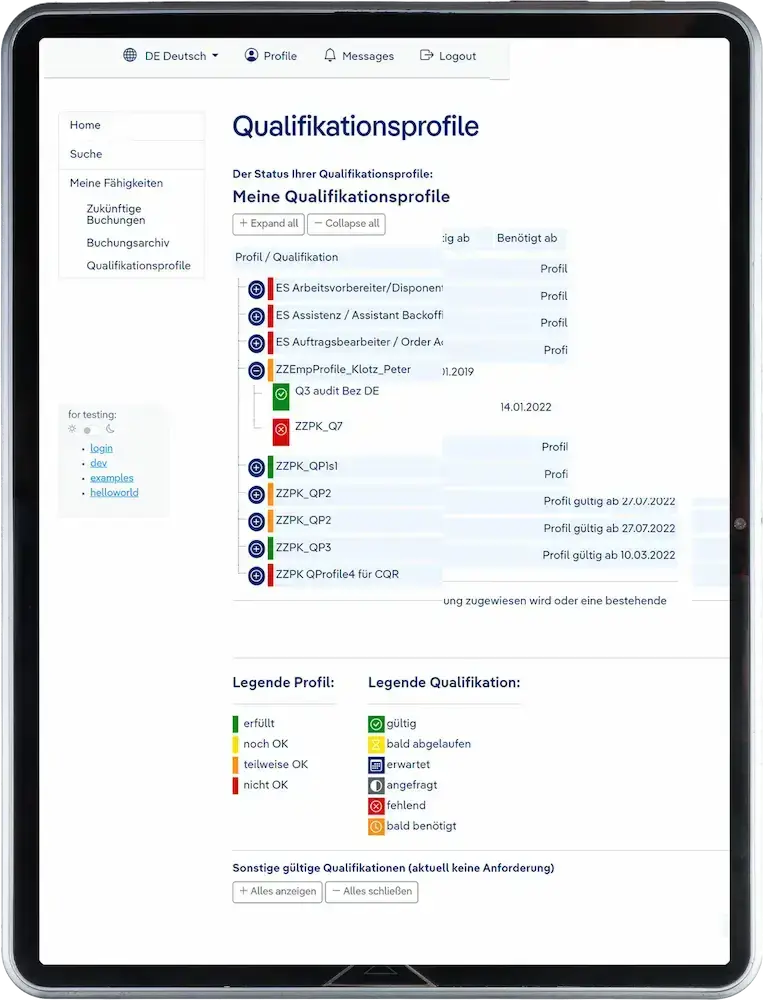Qualifying with Badges and Levels
Companies are increasingly investing in qualification management today to ensure that their employees possess the necessary skills and competencies.
An innovative approach to promote qualification management and boost employee motivation is the integration of gamification elements.
What is it about Gamification & Qualification Management
Gamification refers to the application of playful elements such as points, badges, levels, and rewards in non-gaming contexts to enhance the motivation and engagement of participants.
In qualification management, this can mean that employees, through completing learning units, courses, and tests, not only enhance their qualifications but also receive playful incentives to continuously learn.
Approach to Implementation
The following approach can be used to sensibly integrate gamification elements into the training offerings:

1. Defining Qualifications and Learning Objectives:
-
Qualifications: Qualifications refer to the skills, knowledge, and competencies that employees need to effectively perform their respective tasks or roles within the company. These may include professional certifications, academic degrees, or specific skills required for task fulfillment.
-
Learning Objectives: Learning objectives are clear, measurable goals that define what employees are expected to achieve through their training and development. These objectives should be specific, attainable, relevant, and time-bound (SMART criteria). For example, a learning objective could be for an employee to attain a certain number of certifications in a specific skill by the end of the quarter.
Establishing clear qualifications and learning objectives serves as the starting point for the entire qualification management program. This helps focus on the necessary competencies and ensures that employees know which qualifications they are expected to acquire.

2. Introduction of Learning Units and Courses:
Learning Units: Learning units are small, self-contained segments of learning material that cover specific topics or skills. These can be created in various formats, such as videos, texts, presentations, or interactive modules. Learning units should be clearly structured and aligned with learning objectives.
Courses: Courses are compilations of learning units that build on each other and provide comprehensive training on a particular subject or qualification. Courses may consist of multiple modules and should have a clear curriculum along with assessment methods for measuring learner success. Versatile seminar management is essential for this purpose.
The introduction of learning units and courses enables employees to learn in a structured and goal-oriented manner. These materials and courses should be easily accessible through a learning platform and offered in various formats to cater to different learning styles.
The combination of these two aspects - clear qualifications and learning objectives, along with well-structured learning units and courses - lays the foundation for an effective qualification management program that can be made even more motivating through the incorporation of gamification elements.
The integration of gamification elements such as badges, levels, and point systems into these learning units and courses can further enhance employee motivation and encourage them to improve their qualifications.
3. Integration of Gamification Elements
The integration of gamification elements into a learning platform requires careful planning and implementation. The following steps are helpful for implementing gamification elements into a learning platform:

1. Analysis of Objectives
At the outset, you should establish clear objectives for integrating gamification into your learning platform. Consider the specific outcomes you wish to achieve. For instance, your goals could be:
- Boosting employee motivation for further learning.
- Increasing participation in learning activities.
- Promoting learner success and employee qualification development.
- Creating a rewarding and engaging learning environment.
2. Selection of Appropriate Gamification Elements
Once you have defined your objectives, choose suitable gamification elements that align with these goals.
3. Customization of the Learning Platform
The learning platform should be configured to support the selected gamification elements. This may involve integrating gamification plugins or software solutions that provide the desired functionality. The platform's user interface should also be adapted to make these elements visible and accessible.
4. Clear Rules and Guidelines
It is essential to establish clear rules and guidelines for the gamification elements. This includes criteria for earning badges or advancing in levels, the type of rewards, point distribution, and transparency regarding how everything works.
5. Employee Training
Employees should be informed and trained on how the gamification elements function within the learning platform. Ensure they understand how to earn badges, how the level system operates, and what rewards they can expect.
6. Feedback and Improvement
Continuously collect feedback from employees regarding their use of gamification elements. Identify areas for improvement and adjust the elements accordingly. Employee feedback should be taken into account in the system's further development.
7. Monitoring and Evaluation
Monitor the performance and outcomes of the gamification elements within your learning platform. Analyze whether the set objectives are being met and if employee motivation and participation in learning activities are increasing.
Motivation with Gamification
- Competitive Spirit: Introducing levels and the opportunity to compete with colleagues can stimulate a competitive spirit, which can contribute to increasing motivation for learning.
- Immediate Feedback: Gamification provides instant feedback in the form of rewards and badges, encouraging employees to continuously improve their performance.
- Autonomy: The ability to set and track learning goals independently enhances employees' autonomy and promotes their sense of responsibility.
- Emotional Engagement: Badges and awards can hold emotional value for learners as they create a sense of recognition and belonging.
Gamification Elements
- Badges are digital insignias awarded to employees to mark their learning progress and achievements. They serve not only as a reward but also as a visual symbol of acquired skills or the completion of specific learning objectives.
- Point System: Allocate points for each completed learning unit or passed exam. Employees can accumulate these points and exchange them for rewards.
- A Level System is a way to depict employees' learning progress and provide incentives. Visualizing progress, whether in the form of a bar chart or a graphic, allows employees to track their development and continuously improve.
- Leaderboards: Create leaderboards where employees can see their position compared to their colleagues. This fosters a competitive spirit and encourages participation.
- Challenges and Quests: Regularly provide new challenges or quests that employees can complete to earn additional rewards.

Acceptance within the Company
For gamification to be successful in qualification management, acceptance within the company is crucial. The corporate culture should promote openness to new approaches and changes.

The leadership should support the significance of learning and qualification development, encouraging employees to participate in gamified qualification programs, even beyond mandatory requirements.
Increasing the acceptance of learning achievements within the company can be done in various ways to boost employee motivation and establish a culture of continuous learning.
Increase the acceptance of learning achievements within the company and promote a culture of learning that strengthens the skills and qualifications of employees in the long term, supporting the success of the company.
Steps and approaches to achieve this include:

- Clear Communication of the Importance of Learning: Management should communicate clearly how lifelong learning is crucial for individual success and the success of the company. Employees should understand how their learning efforts contribute to achieving corporate goals.
- Learning Objectives and Career Development: Employees should have the opportunity to set clear learning objectives and see a direct connection between their learning efforts and their career development. This can help boost motivation as employees recognize how their learning improves their career prospects.
- Individually Tailored Training: Individualized training programs that are customized to each employee demonstrate that the company invests in their personal development.
Summary
Overall, the integration of gamification elements with professional qualification management can help boost employee motivation and ensure they continuously improve their skills and qualifications.
Badges, levels, and progress visualizations create a positive learning environment and foster a desire for personal development, but only if they are accepted as awards and learning achievements are duly recognized.
This, in turn, can not only enhance individual performance but also contribute to the success of the entire company.

About us
Since 1998 SoftDeCC is working closely with major training centers and academies. This results in a unique experience with training requirements.
Our Learning Management System is designed to adjust to individual corporate learning processes and address evolving challenges. More...

Contact us
Talk to us about your challenge!
Schedule your free consultation appointment with us at +49 (0)89 / 3090 839 30.





